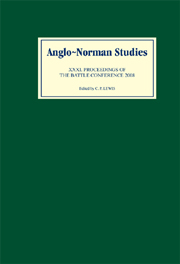Book contents
- Frontmatter
- Contents
- LIST OF ILLUSTRATIONS, MAPS, AND TABLES
- EDITOR'S PREFACE
- ABBREVIATIONS
- Kingship, Lordship, and Community in Eleventh-Century England (R. Allen Brown Memorial Lecture)
- Citadels of God: Monasteries, Violence, and the Struggle for Power in Northern England, 1135–1154
- Writing Civil War in Henry of Huntingdon's Historia Anglorum
- Land, Family, and Depredation: The Case of St Benet of Holme's Manor of Little Melton
- Brothers at Court: Urse de Abetot and Robert Dispenser
- Gerald of Wales and the Prophet Merlin
- The First Hundred Years of the Abbey of Tiron: Institutionalizing the Reform of the Forest Hermits
- All Roads Lead to Chartres: The House of Blois, the Papacy, and the Anglo-Norman Succession of 1135
- The Vita Ædwardi: The Politics of Poetry at Wilton Abbey
- William of Malmesbury, King Henry I, and the Gesta Regum Anglorum
- Twelfth-Century Receptions of a Text: Anglo-Norman Historians and Hegesippus
- LIST OF CONTENTS OF VOLUMES 1–30
Writing Civil War in Henry of Huntingdon's Historia Anglorum
Published online by Cambridge University Press: 12 September 2012
- Frontmatter
- Contents
- LIST OF ILLUSTRATIONS, MAPS, AND TABLES
- EDITOR'S PREFACE
- ABBREVIATIONS
- Kingship, Lordship, and Community in Eleventh-Century England (R. Allen Brown Memorial Lecture)
- Citadels of God: Monasteries, Violence, and the Struggle for Power in Northern England, 1135–1154
- Writing Civil War in Henry of Huntingdon's Historia Anglorum
- Land, Family, and Depredation: The Case of St Benet of Holme's Manor of Little Melton
- Brothers at Court: Urse de Abetot and Robert Dispenser
- Gerald of Wales and the Prophet Merlin
- The First Hundred Years of the Abbey of Tiron: Institutionalizing the Reform of the Forest Hermits
- All Roads Lead to Chartres: The House of Blois, the Papacy, and the Anglo-Norman Succession of 1135
- The Vita Ædwardi: The Politics of Poetry at Wilton Abbey
- William of Malmesbury, King Henry I, and the Gesta Regum Anglorum
- Twelfth-Century Receptions of a Text: Anglo-Norman Historians and Hegesippus
- LIST OF CONTENTS OF VOLUMES 1–30
Summary
The publicity poster for Guillermo del Toro's 2006 film Laberinto del Fauno or Pan's Labyrinth centres on the image of a huge dead tree trunk, split in two, which, as we later learn in the film, is the gateway to a deep cleft in the earth – a dark and strange underground world. Set against the backdrop of the Spanish Civil War, del Toro's film is permeated with images of ruptured earth, splits in the ground, the land literally tearing itself apart to reveal dark and disturbing phenomena within. Whilst the film does include direct representations of violence and atrocity, del Toro's use of metaphor and the alienating, unsettling power of the fantastic offers a far more powerful and affecting evocation of the trauma of civil conflict. Writing civil war is a challenging and difficult project. Civil war is a traumatic experience for both individuals and communities, which resists simple narrative and exceeds the conventions of direct historiographical representation. Whilst direct accounts of the chaos and horror of civil war can be reductive and simplifying, the trauma of civil conflict is often displaced to emerge through metaphor and symbolism. The disturbing experience of civil war can even impact on language itself, affecting style, structure, and voice and leaving perhaps unexpected traces in textual memorials.
This paper will explore how Henry of Huntingdon writes civil war in the Historia Anglorum, with particular focus on book X, ‘De hoc presenti’ or ‘The Present Time’ and its account of the reign of Stephen.
- Type
- Chapter
- Information
- Anglo-Norman Studies 31Proceedings of the Battle Conference 2008, pp. 31 - 48Publisher: Boydell & BrewerPrint publication year: 2009



